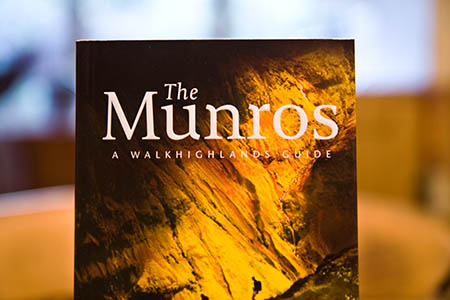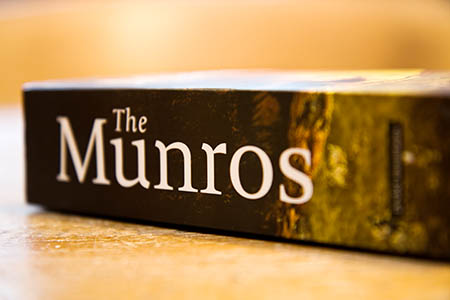The Munros; a Walkhighlands Guide
Paul and Helen Webster
This chunky little guidebook opens with a seemingly contentious statement: “Look beneath the waterproofs of any keen hillwalker in Scotland and, once past the midge bites, it’s likely you will find a Munro-bagger.”
Hang on, I thought. Munrobaggers are a certain type of mountain-goer; obsessed with ticking off another one on the list; the trainspotters of the outdoor world. There are plenty of other worthy hills and mountains north of the border.
Then I examined my own excursions to the uplands of Scotland and had to admit, apart from a day spent in the Moffat hills, every ascent to the high ground had included at least one munro.
I suppose, being the biggest, they draw the keen walker. Look towards the peak of a munro and, if you have any outdoor soul, you will want to be up there.
So this compact, if thick, softback guide is a comprehensive guide to the 3,000-footers, at present numbering 282, which the Scottish Mountaineering Club, guardian of the gilded list, has decided qualify as munros.
The secondary peaks, or munro tops, are not given any special status in this volume, unlike some guidebooks.
Authors Paul and Helen Webster run the popular Walkhighlands website and there are copious plugs for the site within the pages of the book, which become a little tiresome after a while.
However, the style is informal and light and there are features I like. Each mountain is graded for terrain and hazards – which has to be subjective to some degree – but is a good starting point for anyone cautious of more difficult rocky routes.
There is an explanation of the meaning of the mountains’ names though no attempt at phonetically spelling out the pronunciation of Gaelic toponymy.
There is notation on public transport though throughout large tracts of the Highlands this is pretty much non-existent.
Each walk has an estimated time, distance, ascent in metres and a handy six-figure grid reference for the starting point. All the essentials for an excursion up the munro. There is a schematic map of each route, but not one detailed enough to use while walking. The OS map is still an essential piece of kit for each ascent.
The munros are arranged by area, roughly working south to north, with the isles of Skye and Mull completing the set.
There are plenty of colour photographs and information on accommodation although, with time, this is likely to become somewhat out of date.
The book is rounded off with an alphabetical index for those who wish to search for a particular mountain.
Although compact in dimensions, at 10.5 x 14.7cm, The Munros is thick – almost 4cm thick – so will make a weighty and bulky addition to a rucksack. It’s a problem circumvented by other publishers by splitting the whole into northern and southern sections.
Apart from this grouse, The Munros is a handy guide: comprehensive, well written and informative.
Now, where’s that anorak?
The Munros; a Walkhighlands Guide, by Paul and Helen Webster.
Published by pocket mountains ltd, 672 pages
Price: £12.99


Stephen Rawlinson
10 March 2013It is nice that the publishers (Pocket Mountain) have been able to make a full Munro guide that fits in a pocket! So not my greatest concern.
My big grumble, a lot of the routes are pretty standard and average so if you are munroist, there's not much new-stuff to glean.
However, I would add the pictures are some of the best out of any of the Munro guides but maybe not as useful as the Ultimate guides. Another nice feature is that each section starts with a map of the hills PLUS the route choice marked on the map, a nice addition.
Margaret
12 March 2013Why is yet another Munro book needed?
Back in the early 1970s the word Munro was rarely heard, yet people still managed to get up on the Scottish hills.
EigerX
15 March 2013Margaret you comment as though this guide book is being forced on you like another coloured, recycling wheelie-bin.
Sure, you may not glean any knowledge from it, but I dare say there are people new to the delights of the Scottish hills or from overseas who might find it a better option than a bulky hardback at twice the price.
I don't really need it either, but keep a copy in my car's glovebox for it's occasional referral convenience.
Paul and Helen Webster's website "WalkHighlands" is probably the most comprehensive and interactive free site representing Scottish hillwalking on the internet. As such, demand for a complimentary guidebook became apparent, this demand would not have been noticed in the pre worldwide-web 1970's.
Writers, printers, bookbinders, publishers, retailers and consumers need it. It's called a productive ecomony and it's good to see people investing in it!
Stay safe in the hills everyone. :)
Margaret
15 March 2013You miss my point - the whole Munro thing didn't exist in the early 1970s, few people gave more than historical consideration to Hugh Munro's list.
But I agree, mountaineering has become "a market related activity".
As I said in another 'post' - I don't begrudge people new to the delights of the Scottish hills, but it is a shame that more recent adopters may be missing out on something that made mountaineering rather special.
Try some of the writing by Walter Bonatti, to name just one.
EigerX
18 March 2013What is it that these newcomers are missing out on? What do you feel made mountaineering special in the past that can't be found now? Walter Bonatti's rusty pitons maybe?
Bonatti's books are indeed splendid, as are many more of his contemparies, but reflect an age when alpine pioneers were making first ascents.
With 12 deaths on the Scottish mountains already this year, I'd sooner see people following safe, tried and tested routes than trying to emulate the exploits of Walter Bonatti to name just one. ;)
Margaret
19 March 2013If you have to ask you need to dig a bit deeper.
No he doesn't just "reflect an age when alpine pioneers were making first ascents" - try reading his book, 'The Mountains of My Life' published fairly recently.
Others you might like to try are Yvon Chouinard, Doug Scott and Reinhold Messner, all with current views.
Regarding your reference to this years hill incidents, Messner said recently, "I go to the wild mountains where I am responsible for myself. Step by step I am making sure that I don't die. Climbing is an adventure, not a sport. All mountains are dangerous."
Also Jerzy Kukuczka might give a flavour of a period of less commercialised sporting activity.
EigerX
21 March 2013Thanks Margaret, I own a copy of Bonatti's "Mountains of my life" along with shelves full of other works by many great alpinists.
I'm not seeking reading recommendations from you, nor do I hold your apparent disdain for present day "commercial sporting activity".
Did you read Paul and Helen Webster's publication before passing judgement on it?
Margaret
22 March 2013So you possibly don't agree with all that Bonatti writes in 'Mountains of My Life', such as, "Perhaps never has such a massive moral decline been visible in mountaineering as in modern times".
I didn't pass judgement on Paul and Helen Webster's book - I commented, 'Why is yet another Munro book needed?'
Elena
29 March 2013Margaret - I haven't read any of the books by said alpinists, however in my experience, the Munros are far from experiencing a commercialization of any sort (apart from perhaps the tourism built around Ben Nevis).
To me, they still hold that symbol of pure freedom, especially in modern times. I'm curious about the 'moral decline' perspective in mountaineering in relation to the Munros. I can only see it to mean that the societal regulations built up around the landscape have led to a change in mountaineering principles and values.
I don't see harm in another book - however much it is inevitably part of the commercialization process - more information and attention is always good, and if it draws more people to get out and start climbing then all the better. The attention around Munros is nothing like that around Mount Everest at least.